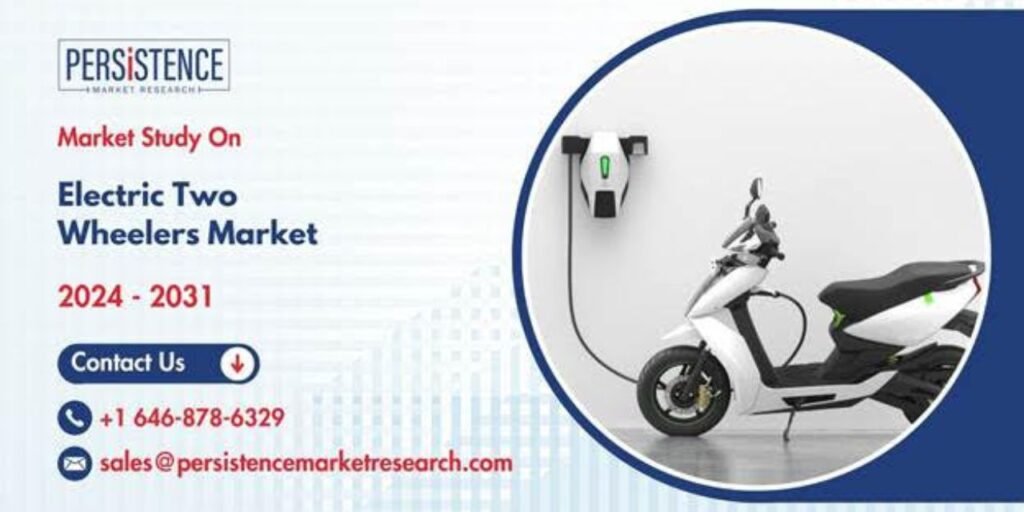
The electric two-wheelers market is undergoing a rapid transformation as consumers and manufacturers embrace the push toward more sustainable transportation. As environmental concerns rise and urban mobility demands evolve, electric two-wheelers are emerging as an attractive alternative to traditional gasoline-powered vehicles. The shift towards cleaner, more efficient modes of transportation is being propelled by innovations in battery technology, government incentives, and growing consumer awareness. By 2025, this market is expected to see tremendous growth, as electric two-wheelers become an integral part of the urban mobility landscape.
A Rapidly Growing Market
According to Persistence Market Research’s projections, the global electric two-wheelers market is predicted to reach a value of US$ 19.6 billion by 2024. It is anticipated to record a compound annual growth rate (CAGR) of 11.6% through the forecast period, reaching a market size of US$ 58.6 billion by 2031. This growth is indicative of the increasing shift toward electric mobility, as consumers and businesses seek greener, more cost-effective alternatives to traditional modes of transport.
Several key factors are driving this impressive market growth, with trends and innovations playing a major role in shaping the electric two-wheeler landscape. Let’s explore the major trends that are expected to dominate the market in 2025 and beyond.
1. Improved Battery Technology
One of the most significant factors influencing the electric two-wheelers market is advancements in battery technology. Electric vehicles (EVs) are only as good as their batteries, and the performance, range, and overall affordability of electric two-wheelers depend heavily on improvements in battery capacity and cost effectiveness.
In recent years, lithium-ion batteries have dominated the market due to their energy density, efficiency, and decreasing costs. However, ongoing research into alternative battery technologies, such as solid-state batteries and lithium-sulfur batteries, promises to further improve the range and performance of electric two-wheelers. These batteries can store more energy in a smaller and lighter package, making them ideal for two-wheeled vehicles.
As battery technology improves, the costs associated with manufacturing and purchasing electric two wheelers will continue to fall, making them more accessible to a wider range of consumers. By 2025, consumers can expect to see longer battery life, faster charging times, and more efficient energy management systems, further boosting the appeal of electric two-wheelers.
2. Government Incentives and Policies
Government support has been a key factor in the growth of the electric two-wheelers market. Many countries around the world are implementing policies and incentives to encourage the adoption of electric vehicles (EVs) as part of their efforts to reduce carbon emissions and combat climate change.
Governments are offering subsidies, tax rebates, and grants to both consumers and manufacturers in an effort to make electric two-wheelers more affordable and to encourage manufacturers to invest in EV technology. In addition to financial incentives, many cities are investing in the development of EV infrastructure, such as charging stations, which makes it easier for consumers to adopt electric two-wheelers.
For instance, in countries like India and China, where pollution is a major concern, electric two-wheelers are seen as a solution to reduce air quality issues and ease traffic congestion. By 2025, it is expected that government initiatives will continue to fuel the growth of the electric two-wheeler market, driving up adoption rates and supporting the transition to greener transportation.
3. Urban Mobility and Traffic Congestion
Urban areas around the world are experiencing unprecedented levels of traffic congestion, leading to longer commutes, pollution, and inefficiency. Traditional vehicles often contribute to these issues, making them less suitable for modern urban environments. Electric two-wheelers, however, offer a unique solution to this problem.
With their smaller size and agility, electric two-wheelers can navigate through crowded urban streets, making them ideal for short-distance travel. Additionally, they require less parking space, making them an attractive option for consumers living in dense urban areas. As cities continue to grow, electric two-wheelers are becoming increasingly popular as a convenient, efficient, and environmentally friendly alternative to cars and motorcycles.
By 2025, the growing demand for last-mile connectivity and the need for urban mobility solutions will continue to shape the electric two-wheeler market. Ride-sharing services, which are already beginning to incorporate electric two-wheelers into their fleets, will also contribute to the rise in electric two-wheeler usage in cities.
4. Cost-Effectiveness and Low Operating Costs
One of the biggest advantages of electric two-wheelers is their low operating costs compared to traditional vehicles. Electric two-wheelers are significantly cheaper to maintain and run than gasoline-powered motorcycles, thanks to their simpler mechanics and fewer moving parts. The cost of electricity is also much lower than gasoline, making electric two-wheelers a more affordable option for daily commutes.
In addition, electric two-wheelers are eligible for government subsidies and incentives, which reduce the upfront costs of purchasing these vehicles. As battery costs continue to decrease and production scales up, the price of electric two-wheelers will become even more competitive with traditional motorcycles and scooters.
By 2025, consumers will increasingly recognize the long-term financial benefits of owning an electric two-wheeler, particularly as energy-efficient options become more widespread and affordable.
5. Design Innovations and Performance Improvements
The electric two-wheeler market is not only growing due to advancements in battery and motor technology but also because of design innovations that enhance the overall performance and appeal of these vehicles. Manufacturers are developing electric two-wheelers that are lighter, more aerodynamic, and capable of higher speeds and greater range.
In addition to performance improvements, electric two-wheelers are becoming more stylish and customizable. Manufacturers are incorporating sleek designs, smart features, and enhanced safety technologies to attract a broader customer base. Features such as smartphone connectivity, GPS navigation, advanced braking systems, and integrated lighting are becoming common in electric two-wheelers, making them more user-friendly and technologically advanced.
By 2025, expect to see a greater variety of electric two-wheelers on the market, ranging from electric scooters to high-performance electric motorcycles, each tailored to meet the needs and preferences of different consumer segments.
6. Rise of Shared Mobility Services
Shared mobility services are revolutionizing urban transportation, and electric two-wheelers are playing an increasingly important role in this shift. Ride-sharing companies like Lime, Bird, and others have already introduced electric scooters to urban areas, and this trend is expected to expand in the coming years.
Electric two-wheelers are ideal for shared mobility services because they are easy to use, require less space, and are environmentally friendly. As shared mobility becomes more widespread, electric two-wheelers will become a popular choice for consumers seeking short-term, affordable, and convenient transportation options.
By 2025, the integration of electric two-wheelers into shared mobility fleets will likely continue to grow, with consumers turning to these services for last-mile connectivity and urban commuting.
Conclusion
The electric two-wheelers market is poised for significant growth by 2025, with trends such as improvements in battery technology, government support, urban mobility needs, cost-effectiveness, design innovations, and the rise of shared mobility services all playing critical roles in shaping its future. As electric two-wheelers become more efficient, affordable, and accessible, they will continue to gain popularity among consumers seeking sustainable and convenient transportation options.
With a projected CAGR of 11.6%, the electric two-wheeler market is expected to reach a size of US$ 58.6 billion by 2031, marking a significant milestone in the transition to a greener, more sustainable future. As these trends continue to evolve, electric two-wheelers will become an integral part of the global transportation ecosystem, offering a cleaner, more efficient solution to urban mobility challenges.
